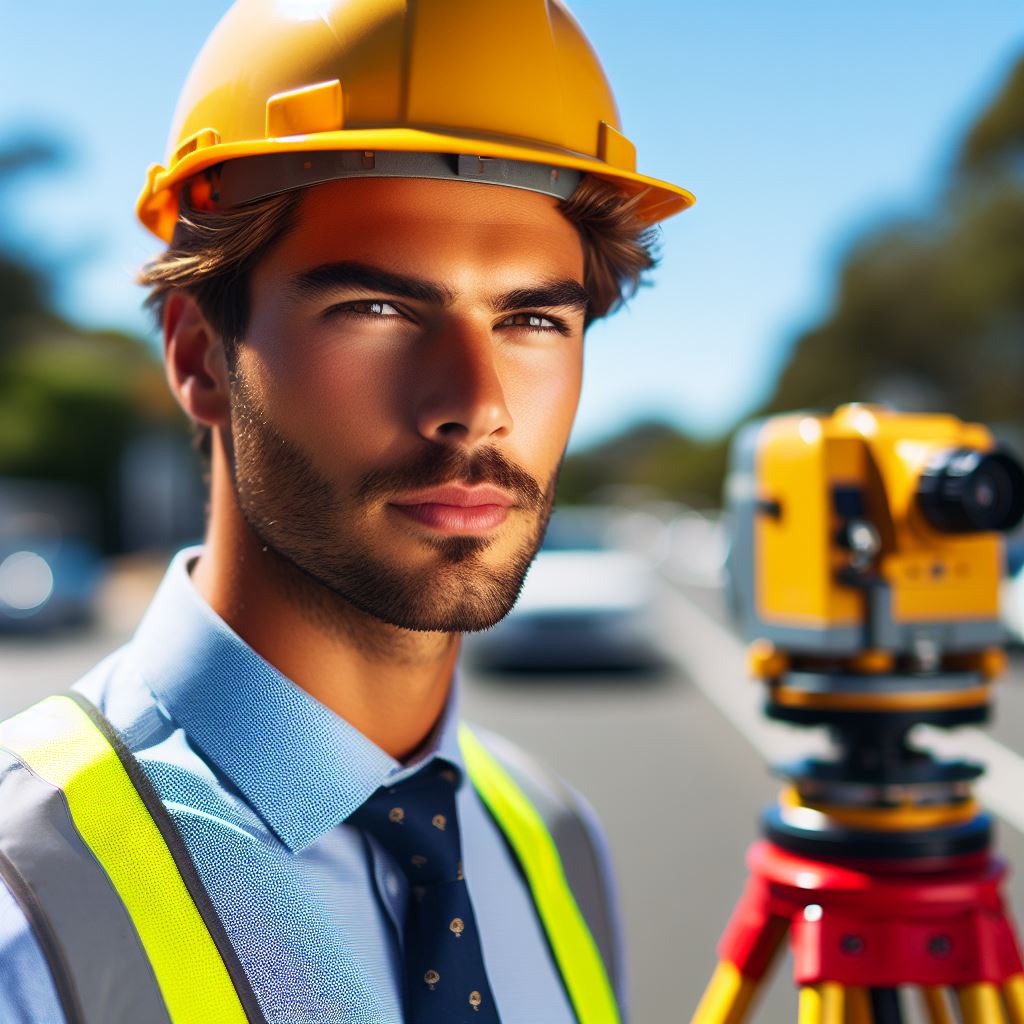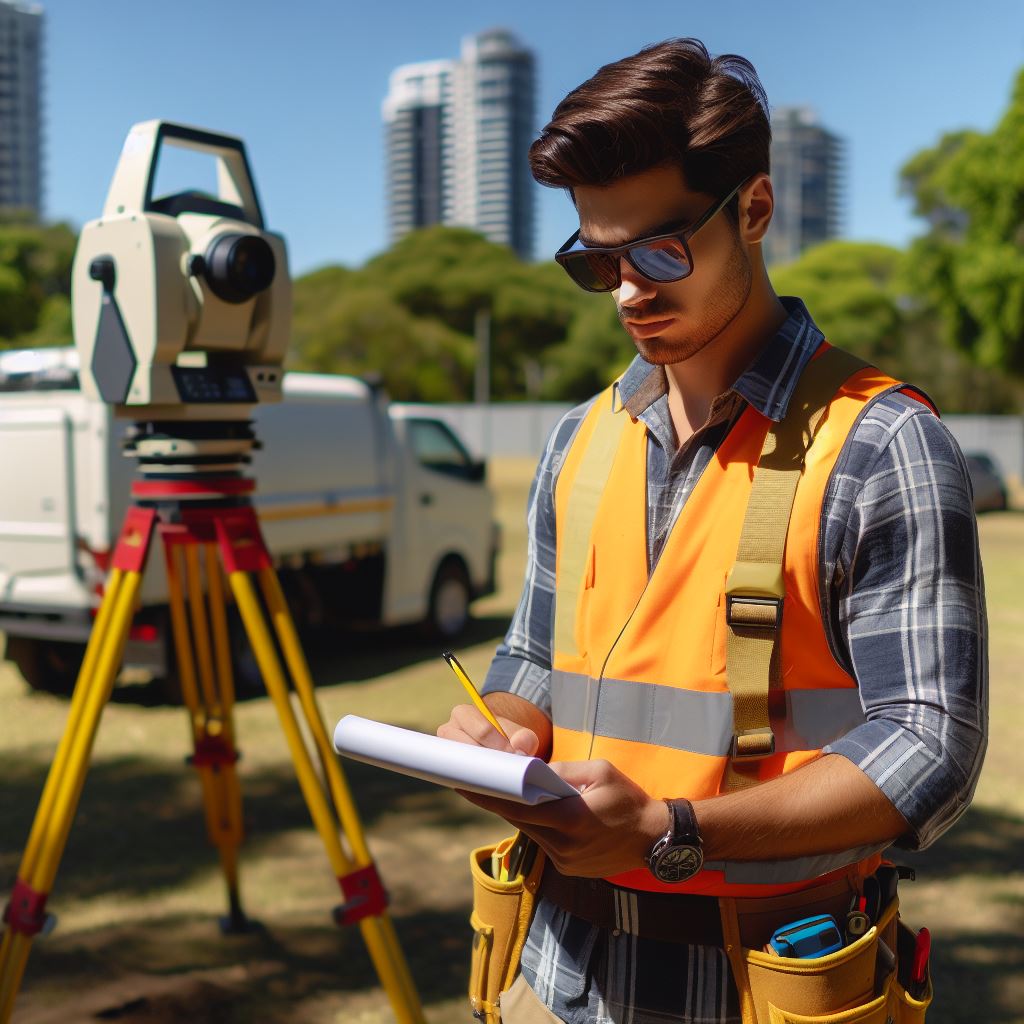Introduction
Surveying technology has revolutionized the way land measurement and mapping are conducted.
With the rapid advancements in technology, it has become essential for surveyors to stay updated with the latest trends in order to remain competitive and deliver high-quality results.
One of the top trends in surveying technology in Australia is the shift towards using drones for aerial mapping and data collection.
Drones equipped with advanced cameras and sensors provide surveyors with accurate and detailed imagery, making data collection faster and more efficient.
This technology enables surveyors to access hard-to-reach areas and obtain real-time data, saving them time and resources.
Another significant trend in surveying technology is the adoption of LiDAR (Light Detection and Ranging) technology.
LiDAR uses laser pulses to measure distances and create highly accurate 3D maps of terrain and structures.
This technology allows surveyors to capture precise elevation and topographic data, enabling them to analyze and plan projects more effectively.
Furthermore, the integration of Geographic Information Systems (GIS) software has transformed surveying practices.
GIS software enables surveyors to store, analyze, and visualize spatial data, resulting in improved decision-making and enhanced project management.
In review, staying updated with surveying tech trends is crucial for surveyors in Australia.
The use of drones, LiDAR, and GIS software has revolutionized the field, providing surveyors with advanced tools and capabilities.
By embracing these technological advancements, surveyors can enhance accuracy, efficiency, and overall project outcomes.
Overview of the Surveying Industry in Australia
Key Role of Surveyors in Various Sectors
Surveyors play a crucial role in numerous sectors across Australia, including construction, mining, and infrastructure development.
Their work involves measuring and mapping the land, ensuring accurate boundaries, and providing essential information for these industries.
In the construction sector, surveyors are fundamental in determining the optimal location for new infrastructure projects.
They assess the terrain, analyze soil conditions, and identify potential risks or challenges that may impact construction.
Similarly, surveyors play an essential role in the mining industry.
They help identify mineral deposits by conducting surveys and mapping out the geological layout of an area.
This information is vital for mining companies, as it enables them to plan their operations effectively and maximize resource extraction.
In infrastructure development, such as the construction of roads, bridges, and railways, surveyors ensure precise measurements and accurate alignments.
They utilize advanced equipment and techniques to create detailed topographic maps and align structures with the existing landscape.
Growth and Opportunities in the Surveying Industry
The surveying industry in Australia is experiencing significant growth, primarily due to the country’s expanding construction and infrastructure sectors.
As the population continues to increase, there is a growing demand for new buildings, transportation networks, and urban developments.
This trend presents numerous opportunities for surveyors in Australia.
The construction industry, in particular, is expected to see substantial growth in the coming years, creating a high demand for qualified surveying professionals.
Additionally, the mining sector continues to thrive, providing further opportunities for surveyors to contribute their expertise.
Moreover, the increasing focus on sustainable development and environmental conservation has opened new avenues for surveyors.
Their skills are vital for conducting environmental impact assessments and ensuring that projects adhere to strict regulations and guidelines.
Need for Technological Advancements in Surveying
To meet the evolving demands of the surveying industry, technological advancements are essential.
Traditional surveying methods, while reliable, can be time-consuming and labor-intensive.
Therefore, there is a need for innovative tools and techniques that can enhance efficiency and accuracy.
One technology that has revolutionized the surveying industry is Geographic Information Systems (GIS).
GIS enables surveyors to capture, analyze, and interpret spatial data more efficiently.
It allows for better visualization and decision-making, leading to more informed planning and development processes.
Another significant advancement is the use of remote sensing technologies, such as LiDAR (Light Detection and Ranging) and aerial drones.
These tools provide surveyors with a faster and more detailed overview of a given area, enabling them to collect data from challenging terrains and inaccessible locations.
Furthermore, the integration of Real-Time Kinematic (RTK) GPS systems and robotic total stations has significantly improved surveying accuracy.
These advanced tools allow surveyors to obtain precise measurements in real-time, reducing errors and increasing productivity.
In essence, the surveying industry in Australia plays a vital role in various sectors, including construction, mining, and infrastructure development.
With the country’s continued growth and development, the demand for skilled surveying professionals is on the rise.
To meet the industry’s needs, technological advancements are crucial, offering enhanced efficiency and accuracy for surveying professionals.
Read: Challenges Faced by Modern Architects
Current surveying tech trends in Australia
As technology continues to advance, the field of surveying in Australia experiences significant trends that shape the industry.
This section explores the current surveying tech trends in Australia, including the integration of drones, adoption of LiDAR technology, and utilization of GIS (Geographic Information System).
Integration of drones in surveying
In recent years, the use of drones has become increasingly common in surveying practices.
Drones, equipped with high-resolution cameras or LiDAR sensors, offer numerous benefits that enhance surveying operations.
Benefits of using drones in surveying
Using drones in surveying provides several advantages.
Firstly, drones can access hard-to-reach or hazardous areas, minimizing the need for manual inspection.
Secondly, drones can collect data at a faster rate, significantly reducing project timeframes.
Moreover, drones equipped with LiDAR sensors can capture highly detailed 3D information, enabling accurate mapping and visualization of terrain, structures, and assets.
Finally, the use of drones reduces costs by eliminating the need for costly equipment or labor-intensive processes.
Challenges and regulations for drone surveying
While the integration of drones in surveying offers immense potential, it also faces challenges and regulations.
One of the primary challenges is airspace restrictions and safety concerns.
Drone operators must adhere to strict regulations imposed by the Civil Aviation Safety Authority (CASA) to ensure safe operations.
Additionally, privacy issues may arise when conducting surveys with drones, requiring surveyors to obtain necessary approvals and permissions.
Adoption of LiDAR technology
LiDAR technology has rapidly gained popularity in the surveying industry due to its ability to produce highly accurate and detailed data.
Explanation of LiDAR technology and its applications in surveying
LiDAR, which stands for Light Detection and Ranging, is a remote sensing technology that uses laser beams to measure distances.
In surveying, LiDAR sensors mounted on drones or aircraft emit laser pulses towards the ground, capturing precise elevation data and reflecting objects.
This technology enables the creation of detailed 3D models, topographic maps, and point clouds, which are valuable in various industries such as construction, urban planning, and environmental monitoring.
Advantages of LiDAR over traditional surveying methods
Compared to traditional surveying methods, LiDAR technology offers several advantages. Firstly, LiDAR allows for rapid data collection over large areas, reducing survey time and costs.
Secondly, LiDAR provides highly accurate and precise measurements, even in complex terrains.
Thirdly, LiDAR data can be easily integrated into GIS platforms, enabling efficient analysis and visualization.
Finally, LiDAR can capture information that is not visible to the naked eye, such as tree canopy heights or building facades, enhancing the overall understanding of the surveyed environment.
Utilization of GIS (Geographic Information System)
GIS plays a crucial role in modern surveying practices, providing a powerful framework for data integration, analysis, and visualization.
Overview of GIS and its relevance to surveying
GIS is a technology that captures, manages, analyzes, and presents spatial or geographic data.
In surveying, GIS allows for the integration of multiple data sources, such as survey measurements, satellite imagery, and demographic information, in a geospatial context.
Surveyors can utilize GIS to organize and analyze data effectively, identify patterns or trends, and make informed decisions regarding land use, infrastructure development, or resource management.
Examples of how GIS enhances surveying operations
GIS provides numerous benefits to surveying operations. It enables surveyors to create accurate and up-to-date maps by overlaying different datasets and visualizing survey data spatially.
GIS also facilitates data sharing and collaboration among surveying teams, stakeholders, and other professionals involved in the project.
Furthermore, GIS-based analysis allows for better understanding of complex spatial relationships, enabling efficient decision-making and improved planning and design processes.
Your Personalized Career Strategy
Unlock your potential with tailored career consulting. Get clear, actionable steps designed for your success. Start now!
Get StartedIn summary, the surveying industry in Australia is witnessing significant technological advancements.
Integration of drones, adoption of LiDAR technology, and utilization of GIS have revolutionized surveying operations, providing improved efficiency, accuracy, and decision-making capabilities.
As these tech trends continue to evolve, it is essential for surveying professionals to stay updated and embrace these innovations for a successful and sustainable future.
Read: Historic Preservation in Australian Architecture

Emerging surveying tech trends in Australia
The field of surveying in Australia is constantly evolving, driven by emerging technologies that promise to revolutionize traditional workflows.
Two key trends in this field are the integration of Artificial Intelligence (AI) and the use of Augmented Reality (AR) and Virtual Reality (VR) technologies.
These advancements offer unique opportunities and challenges for surveying professionals, with the potential to significantly improve efficiency and accuracy in a wide range of applications.
Artificial Intelligence (AI) in surveying
The integration of AI into surveying has the potential to transform the industry in numerous ways.
AI algorithms can automate data analysis, enabling surveyors to quickly process large datasets and extract valuable insights.
Additionally, AI technologies can be utilized for object recognition, allowing for automated identification and classification of features in survey data.
Potential applications of AI in surveying
By implementing AI in surveying workflows, there are several benefits that can be realized.
For example, AI can greatly enhance efficiency by minimizing the time spent on manual data analysis tasks.
This enables surveyors to focus on more complex and specialized tasks that require human expertise.
Moreover, AI algorithms can reduce human errors, resulting in more accurate survey outcomes.
Benefits and challenges of implementing AI in surveying workflows
However, the implementation of AI in surveying also brings challenges. One such challenge is ensuring the privacy and security of sensitive survey data.
There is a need for robust data protection measures to safeguard confidential information.
Additionally, the potential bias in AI algorithms should be carefully addressed, as it can impact the reliability and fairness of surveying results.
Continuous monitoring and improvement of AI models are essential to mitigate these challenges.
Augmented Reality (AR) and Virtual Reality (VR)
AR and VR technologies offer exciting possibilities for enhancing surveying processes.
AR can provide real-time visualization of survey data, superimposing digital information onto the real-world environment.
This enables surveyors to overlay survey measurements and models onto physical sites, aiding in better understanding and decision-making.
How AR and VR can enhance surveying processes
Similarly, VR can create immersive virtual environments that allow surveyors to explore and interact with survey data as if they were on-site.
This technology empowers stakeholders to visualize and experience projects before they are built, facilitating effective communication and collaboration.
Example case studies of AR and VR in surveying
Several case studies demonstrate the benefits of AR and VR in surveying.
For example, using AR goggles, surveyors can visualize underground utilities in real-time, significantly reducing the risk of damaging existing infrastructure.
In another case, a VR model of proposed architectural designs allowed stakeholders to experience the project and provide valuable feedback, resulting in improved project outcomes.
In fact, the integration of AI and AR/VR technologies in surveying is a significant trend in Australia.
These emerging technologies offer immense potential to enhance efficiency, accuracy, and decision-making in surveying workflows.
However, it is crucial to address challenges such as data privacy and algorithmic bias to ensure the responsible and effective implementation of these technologies in the field.
By embracing and adapting to these trends, surveying professionals can stay at the forefront of the industry and deliver superior results to their clients.
Read: Surveying 101: An Aussie’s Intro to the Field
Implications of surveying tech trends
The rapid advancement of technology has greatly impacted various professions, including the field of surveying in Australia.
The emergence of new surveying tech trends has brought about significant implications for both surveying professionals and their clients.
Understanding these implications is essential for staying ahead in an increasingly tech-driven industry.
Impact on surveying professionals
Skills and knowledge required for tech-driven surveying
As surveying technology continues to evolve, professionals in the field need to keep up with the latest advancements.
Traditional surveying methods are being replaced by innovative tools and techniques such as drone mapping, laser scanning, and Geographic Information Systems (GIS).
Surveyors must invest time and effort in acquiring skills like data analysis, software proficiency, and remote sensing to effectively utilize these technologies.
Importance of continuous learning and professional development
To remain competitive, surveying professionals must engage in continuous learning and professional development.
Technology trends are constantly changing, and surveyors need to stay updated with the latest software and equipment.
Participating in training programs, attending conferences, and joining professional organizations can help surveyors stay informed about cutting-edge tools and techniques.
Continuous learning will ensure that surveying professionals can effectively navigate the evolving tech landscape and offer enhanced services to their clients.
Stand Out with a Resume That Gets Results
Your career is worth more than a generic template. Let us craft a resume and cover letter that showcase your unique strengths and help you secure that dream job.
Get HiredBenefits for clients and projects
Improved accuracy and efficiency in surveying deliverables
Tech-driven surveying enables professionals to deliver highly accurate and precise surveying outputs.
Applications like drone mapping and laser scanning provide detailed imagery and data that traditional methods may struggle to match.
This enhanced accuracy not only benefits clients who rely on accurate measurements but also facilitates better decision-making in various industries such as construction, urban planning, and agriculture.
Cost and time savings for clients
By adopting surveying technology, clients can realize significant cost and time savings.
Traditional surveying methods often involve manually collecting data, which can be time-consuming and labor-intensive.
Tech-driven approaches streamline data collection processes, reducing the need for extensive fieldwork and manual calculations.
This ultimately leads to faster project completion times, cost savings for clients, and increased overall efficiency.
In the end, the implications of surveying tech trends in Australia are far-reaching.
Surveying professionals must adapt to rapidly evolving technology by acquiring new skills and continuously investing in their professional development.
Clients can benefit from improved accuracy, efficiency, and cost savings as surveying professionals leverage the full potential of tech-driven surveying techniques.
Embracing these trends is essential for the growth and success of the surveying industry in Australia.
Read: Project Management Tips for Architects
Learn More: The Future of Mech Engineering in Australia
Conclusion
Recap of the key surveying tech trends in Australia
In this blog section, we discussed several key surveying tech trends that are shaping the industry in Australia.
Drones survey terrain, businesses embrace GIS, surveying incorporates AR and VR, and data analytics gains significance.
Importance of embracing and adapting to technological advancements
These trends have revolutionized the surveying profession by enabling faster and more accurate data collection.
Improving the efficiency of surveying projects, and enhancing the overall quality of deliverables.
By embracing and adapting to these technological advancements, surveying professionals can stay competitive in the industry and provide better services to their clients.
Encouragement for professionals to stay updated with the latest tech trends in the field
To remain relevant and successful in the rapidly evolving surveying industry, professionals must stay updated with the latest tech trends.
This can be achieved through continuous learning, attending industry conferences and workshops, joining professional associations, and networking with peers.
By keeping pace with technological advancements, surveying professionals can unlock new opportunities and gain a competitive edge in their careers.
In the end, the surveying industry in Australia is experiencing a significant transformation due to the emergence of advanced technologies.
Surveying professionals must embrace and adapt to these trends to stay ahead of the competition and provide exceptional services to their clients.
By staying updated with the latest tech trends, professionals can navigate the changing landscape of the surveying industry and thrive in their careers.




